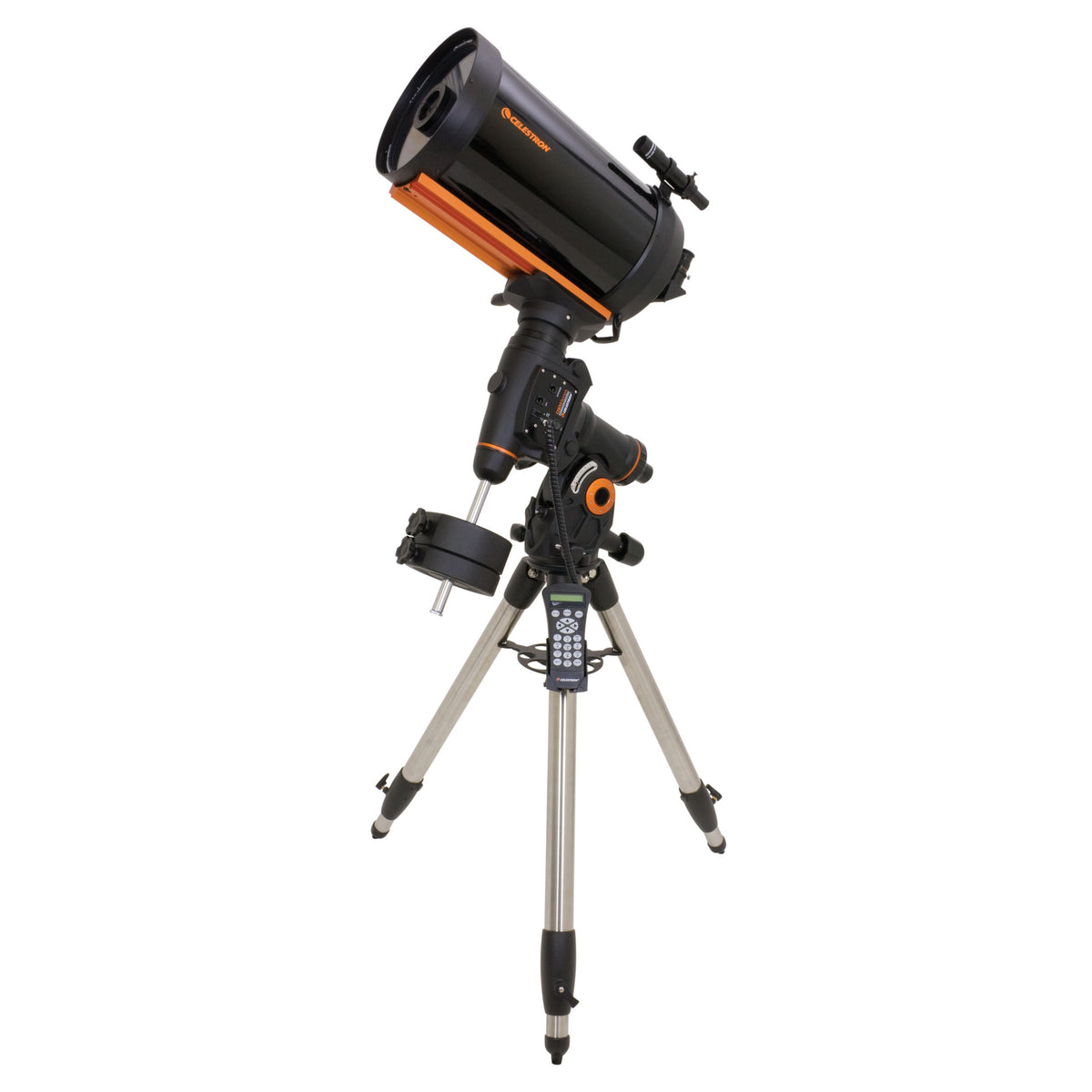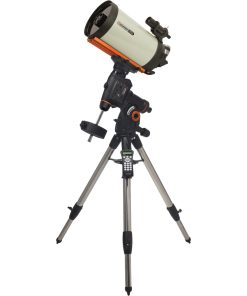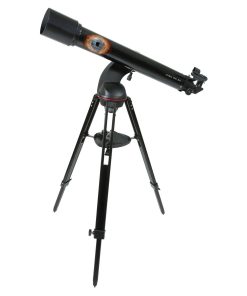Celestron CGEM 925 Schmidt-Cassegrain Telescope – 11098 Celestron
$ 2.799,00 $ 699,75
Celestron’s CGEM-925 features our high-end 9.25″ Schmidt Cassegrian OTA with XLT coatings mounted on our brand new CGEM™ mount.
The Celestron CGEM™ mount has a fresh, attractive, bold appearance and is capable of carrying Celestron’s higher-end SCT optical tubes (up to 11″) securely and vibration free which is ideal for both imaging and visual observing.
Ergonomic Design – CGEM was designed to be ergonomically friendly with large Altitude and Azimuth adjustment knobs for quick and easy polar alignment adjustment. The internal RA and DEC motor wiring provides a clean look and an easy and trouble free set up.
Innovation – The CGEM series has a new innovative Polar alignment procedure called All-Star™ (patent pending). All-Star allows users to choose any bright star, while the software calculates and assists with polar alignment. Another great feature of the CGEM, sure to please astroimagers, is the Permanent Periodic Error Correction (PEC) which will allow users to train out the worm gears periodic errors, while the mount retains the PEC recordings.
Performance – For objects near the Meridian (imaginary line passing from North to South), the CGEM will track well past the Meridian for uninterrupted imaging through the most ideal part of the sky. The CGEM mount has a robust database with over 40,000 objects, 400 user defined programmable objects and enhanced information on over 200 objects.
Celestron’s CGEM mount is the perfect fit between the Advanced Series and CGE Series. Offering the portability of the Advanced Series and the precision of the CGE.
High-Performance Features
- CGEM Computerized Equatorial Mount
- Ultra sturdy 2″ steel tripod with Accessory Tray
- 6×30 Finderscope for easy centering of objects
- 40,000 object database with 400 user-definable objects and expanded information on over 200 objects
- Proven NexStar computer control technology
- Flash upgradeable hand control software and motor control units for downloading product updates over the Internet
- New “All-star” Polar alignment uses any bright star for a quick and accurate Polar alignment
- Software Features include: Mount Calibration, Database Filter Limits, Hibernate, five Alignment Procedures, and user-defined slew limits
- Custom database lists of all the most famous deep-sky objects by name and catalog number; the most beautiful double, triple and quadruple stars; variable star; solar systems; objects and asterisms
- Permanent programmable periodic error correction (PEC) – corrects for periodic tracking errors inherent to all worm drives
- Flash upgradeable hand control software and motor control units for downloading product updates over the Internet
- Custom database lists of all the most famous deep-sky objects by name and catalog number; the most beautiful double, triple and quadruple stars; variable star; solar systems; objects and asterisms
- Steel worm gear and 90mm pitch diameter brass worm wheel
- Drive Motors – Low Cog DC Servo motor with integrated optical encoders offer smooth, quiet operation and long life. The motor armatures are skewed to minimize cogging which is required fro low speed tracking.
- Internal Cable wiring for trouble-free setup and transportation
- Designated six-pin RJ-12 modular jack, ST-4 compatible guide port
- Double line, 16-character Liquid Crystal Display Hand Control with backlit LED buttons for easy operation of goto features
- Autoguide port and auxiliary ports located on the electronic pier for long exposure astrophotography
- RS-232 communication port on hand control to control the telescope via a personal computer
- Includes NexRemote telescope control software, for advanced control of your telescope via computer
- GPS-compatible with optional CN16 GPS Accessory
Specifications
- MOUNT: Computerized Equatorial
- TRIPOD: Adjustable, Stainless Steel
- CD ROM: NexRemote control software with RS232 cable
- POWER SUPPLY: Car battery adapter
- TRIPOD WEIGHT: 17 lb (7.71 kg)
- MOUNT WEIGHT: 41 lb (18.6 kg)
- COUNTERWEIGHTS: 1 x 17 lb
- MOTOR DRIVE: Low cog DC Servo motors with encoders, both axes
- COMPUTER HAND CONTROL: Double line, 16 character Liquid Crystal Display; 19 fiber optic backlit LED buttons
- SLEW SPEEDS: Nine slew speeds: 4 °/sec, 2 °/sec, .5 °/sec, 64x, 16x, 8x, 4x, 1x, .5x
- TRACKING RATES: Sidereal, Solar and Lunar
- TRACKING MODES: EQ North and EQ South
- ALIGNMENT PROCEDURES: AutoAlign, 2-Star Align, Quick Align, 1-Star Align, Last Alignment, Solar System Align
- SOFTWARE PRECISION: 24bit, 0.08 calculation
- DATABASE: 40,000+ objects, 400 user defined programmable objects. Enhanced information on over 200 objects
- POWER REQUIREMENTS: 12 VDC 1.5 Amp
- GPS: Optional CN-16 GPS Accessory
About Celestron Schmidt-Cassegrain Telescopes
Celestron’s excellent Schmidt-Cassegrain telescopes are compact and portable and represent the best all-purpose design for a wide variety of uses from terrestrial and deep sky viewing to astrophotography.
Catadioptrics use a combination of mirrors and lenses to “fold” (reflect) the light path and form an image. In a Schmidt-Cassegrain, the light enters through a thin aspheric Schmidt correcting lens. It then strikes the spherical primary mirror. It is reflected back up the tube and intercepted by a small secondary mirror which reflects the light out an opening in the rear of the instrument where the image is formed at the eyepiece.
Catadioptrics are the most popular and most modern type of telescope optical design and are marketed throughout the world in 3.5″ and larger apertures. Catadioptric telescopes combine the practical advantages of lenses and mirrors while eliminating their disadvantages. They offer the clarity and contrast of refractors with the low aberration of reflectors. Catadioptrics have an average focal ratio of f/10, which is wide enough for all types of photography. They are also easier to maintain because all optical elements are solidly mounted and rigidly collimated. Catadioptric telescopes provide the best possible combination of light gathering power, long focal length, portability and affordability.
Schmidt-Cassegrain Advantages
- Very versatile, best all-purpose telescope design
- Combines the optical advantages of both lenses and mirrors while eliminating their disadvantages
- Excellent optics and razor sharp images over a wide field
- Excellent for deep sky observing and astrophotography as well as terrestrial viewing
- Very good for lunar, planetary and binary star observing
- Focal ratio generally around f/10, it also has the best near focus capability of any type of telescope
- Closed tube design reduces image-degrading air currents
- Extremely compact and portable
- Easy to use, durable and virtually maintenance free
- Large apertures at reasonable cost and less expensive than equivalent aperture refractors
- More accessories available than with other types of telescopes
Schmidt-Cassegrain Disadvantages
- More expensive than Newtonians of equal aperture
- Slight light loss due to secondary mirror obstruction compared to refractors The Maksutov-Cassegrain is similar to the Schmidt-Cassegrain with essentially the same advantages and disadvantages. It uses a thick meniscus correcting lens with a strong curvature and a secondary mirror that is usually an aluminized spot on the corrector.
Celestron All-Star Polar Alignment Technology
All-Star Polar Alignment Technology
German Equatorial Mounts (GEM) have long since been recognized as the mount of choice for astrophotography. Needing to track in only one axis for long exposures; adjustable counterweights and tube position for perfect balance, the GEM has few short comings when it comes to imaging. In order to do long-exposure astro-imaging, an equatorially aligned telescope is needed to allow your telescope to properly track the motion of the sky. However accurate tracking still depends on an accurate polar alignment. Even with a visible star very near the North Celestial Pole (NCP), the true celestial pole can be a very elusive place to find without assistance.
Now select Celestron mounts can utilize a new innovative Polar alignment procedure called All-Star™. All-Star allows users to choose any bright star, while the software calculates and assists with polar alignment.
Here’s how it works.
Once your telescope is aligned with two bright star, All-Star allows you to choose any bright star listed in the NexStar hand control to assist in accurately aligning your telescope’s mount with the North Celestial Pole. Using the telescope’s Sync function, the mount is able to point and center a bright star with a high degree of accuracy. Once centered, the mount will point the telescope to the exact position that the star should be if the mount were precisely polar aligned. By simply adjusting the mounts altitude and azimuth controls to re-center the star in the center of the eyepiece, you are actually moving the mounts polar axis to the exact position of the North Celestial Pole.
FAQ
Can I use Polaris to polar align my telescope?
Since Polaris is very close to the NCP and not very bright, it is actually not a recommended star for the “All-Star” method. The advantages of being able to use stars other than Polaris are two fold:
Polaris is not always visible. So not only can you use a variety of other stars but they are also brighter and more prominent.
The star you choose will be farther away from the NCP thus allowing for greater accuracy when centering the star in your eyepiece.
Which stars are best to use for polar aligning?
For best results choose a bright alignment star that is near the Meridian, preferably close to the celestial equator. Try to avoid stars that are close to the west/east horizon or directly overhead because they can be more difficult to center using the mount’s altitude and azimuth controls. Also stars too near the celestial pole are less accurate than those further away.
Will I lose my alignment after I polar align?
No, the mount will retain its alignment but some amount of accuracy may be compromised depending on how much the mount has been moved during polar alignment. Although the telscopes tracking may be very good, pointing accuracy may need to be improved, especially if you are trying to located small objects on a ccd chip.
What are the steps to polar align my telescope using “All-Star” polar alignment?
- Align the telescope with the sky using the “Two-Star Alignment” method.
- Select a suitable bright star from the Hand Control’s database and slew the telescope to the star.
- Press the Align button and select Polar Align => Align Mount from the list.
- The telescope will then re-slew to the alignment star and ask you to center it in the eyepiece in order to “Sync” on the star.
- The telescope will slew to the position that the star should be if it were accurately polar aligned.
- Use the mounts altitude and azimuth adjustments to place the star in the center of the eyepiece and press the Align button.
- Update the telescope’s star alignment if necessary.
Quick Shipping and Professional Packaging
Due to our longstanding partnership with UPS FedEx DHL as well as other major international carriers, we are able to provide various shipping options. Our warehouse personnel are well trained and will be able to pack your goods in accordance with the exact and precise specifications. Your goods are thoroughly checked and securely secured prior to shipment. Everyday we deliver hundreds of packages to our customers from all over the world. Our determination to be the biggest online retailer in the world is shown by this. The warehouses are located situated in Europe in the same way as they are in the USA.
Note: Orders containing multiple items will have a separate processing period for each item.
We will carefully examine all products before they are shipped. Today, the majority of orders will be delivered within 48 hours. The delivery time will be between 3-7 working days.
Returns
We don't manage the stock at our warehouse and factory. The actual inventory may fluctuate at any time. It's possible that you may not receive your order once it's been placed.
Our policy is for 30 days. We are unable to return or exchange your purchase after 30 days since the purchase.
In order for your item to be eligible for return the item must not be opened and in the condition you received it. It must also remain in the original packaging.
Related products
Discontinued
Discontinued
Baader Planetarium 2 Inch Steeltrack Crayford Focuser for Refractor Telescopes – BDS-RT Baader
Discontinued
Discontinued
Discontinued
Baader Planetarium SteelDrive Focusing System for Baader Steeltrack Focusers – FOC-DRV Baader
Discontinued
Celestron DSLR Camera Attachment Kit for Schmidt-Cassegrain Telescopes – CELE399-2 Celestron
Discontinued
Discontinued
Discontinued


















































